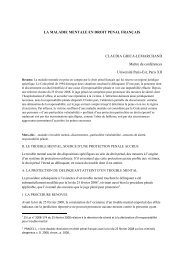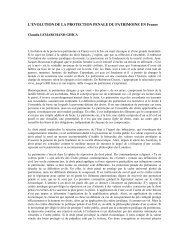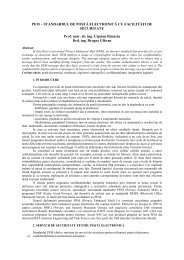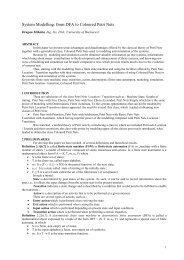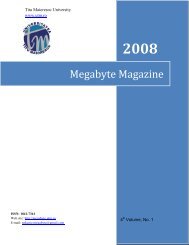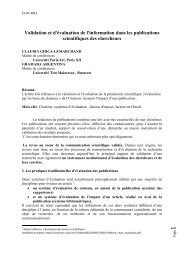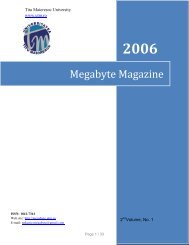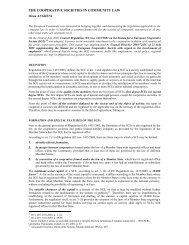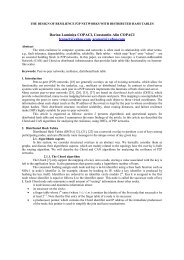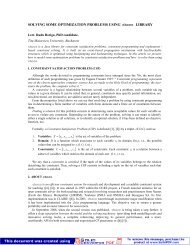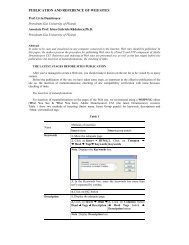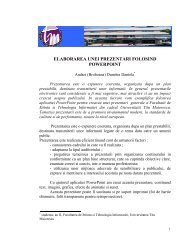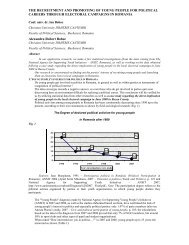advantages and disadvantages regarding the itc use ... - MegaByte
advantages and disadvantages regarding the itc use ... - MegaByte
advantages and disadvantages regarding the itc use ... - MegaByte
You also want an ePaper? Increase the reach of your titles
YUMPU automatically turns print PDFs into web optimized ePapers that Google loves.
ADVANTAGES AND DISADVANTAGES REGARDING THE I.T.C. USE DURING<br />
TEACHING<br />
Maria Ocnărescu<br />
Grup Şcolar “Doamna Stanca”, Bucharest<br />
Gabriela Jicmon<br />
Grup Şcolar “Doamna Stanca”, Bucharest<br />
Abstract: Introducing educational I.T.C. in schools has a strong impact on didactical strategies <strong>and</strong> on <strong>the</strong><br />
development organizing types of training which are not allowed by <strong>the</strong> traditional methods <strong>and</strong> means.<br />
Learning process is no longer regarded as a consequence of <strong>the</strong> teachers activities, but <strong>the</strong> result of <strong>the</strong><br />
interaction between students <strong>and</strong> <strong>the</strong> one which leads learning processes thru <strong>the</strong> computer, information sources<br />
at students disposal(Internet, encyclopedias).<br />
I.T.C. implementation in physics lessons involves identification of <strong>the</strong> goals <strong>and</strong> of <strong>the</strong> competences requested by<br />
<strong>the</strong> curricula, electing appropriate didactical software <strong>and</strong> ensuring <strong>the</strong> necessary hardware.<br />
While <strong>the</strong> economical changes occur very often suddenly, in <strong>the</strong> educational one <strong>the</strong>y are happening slowly<br />
<strong>and</strong> following different steps dew not only to subjective factors (human elements involved in it, both teachers<br />
<strong>and</strong> students), but also to objective ones (poor material base, long needed time for <strong>the</strong> teachers reinstruction, but<br />
not only).<br />
A.M. Hubermann [2] in 1978 announced <strong>the</strong> main types of changes made by <strong>the</strong> new discoveries in <strong>the</strong><br />
communication <strong>and</strong> information fields as follows:<br />
- ‘material’ changes (<strong>the</strong> <strong>use</strong> of modern equipments: computers, video projectors),<br />
- changes concerning “conceiving” <strong>the</strong> curricula <strong>and</strong> <strong>the</strong> teaching methods,<br />
- interpersonal changes( teacher- student, teacher- teacher, teacher- administrative staff).<br />
In <strong>the</strong> same time it can be said that <strong>the</strong> educational system can be influenced by <strong>the</strong> technological progress as<br />
follows:<br />
- as launching “engine” of <strong>the</strong> new educational system,<br />
- as way of improve <strong>the</strong> actual system.<br />
Learning means processing more <strong>and</strong> more complex in formations, <strong>and</strong> solving exercises <strong>and</strong> problems, in<br />
transferring new knowledge <strong>and</strong> elements in new terms.<br />
Like that learning becomes active, constructive, oriented towards a precise goal <strong>and</strong> cumulative, as Shell<br />
showed in 1988.<br />
• Is active beca<strong>use</strong> <strong>the</strong> student works with <strong>the</strong> received information while some goals must be achieved <strong>and</strong><br />
has to develop <strong>the</strong> requested tasks.<br />
• Is constructive beca<strong>use</strong> <strong>the</strong>re is an two way connection between <strong>the</strong> old knowledge <strong>and</strong> those knowledge<br />
which are supposed to be learned in order to ensure learning of more <strong>and</strong> more complex notions.<br />
• Is oriented towards a precise goal, beca<strong>use</strong> motivation is one of <strong>the</strong> main elements of education, <strong>and</strong><br />
students are answering better to tasks for which <strong>the</strong>y know <strong>the</strong> final goal.<br />
• Is cumulative beca<strong>use</strong> it’s based on previous learned notions which represent <strong>the</strong> base of new cognitive<br />
achievements.<br />
In this way teaching became an open media, with high degree of independence <strong>and</strong> responsibility from <strong>the</strong><br />
student point of view.<br />
They have to settle <strong>the</strong>mselves a goal <strong>and</strong> follow it’s achievement, to value <strong>the</strong> learned notions <strong>and</strong> to ensure<br />
an efficient feed-back (to verify <strong>the</strong> coincidence between goals <strong>and</strong> results).<br />
Thru this an educational ideal is reached: „<strong>the</strong> engaged learning”.<br />
Factors involved into influencing <strong>the</strong> effects of technological teaching media upon subjects <strong>and</strong> vice versa<br />
are: previous learned knowledge, motivation, learning style, self-control.<br />
In 1986 Wilson <strong>and</strong> Anderson believed that is as easy for someone to get more knowledge <strong>regarding</strong> a field<br />
as that person already possesses more knowledge <strong>and</strong> experience in that very domains.<br />
• Previous learned knowledge allow a better selection between <strong>the</strong> essential <strong>and</strong> adjacent notions, as<br />
attributing more senses to <strong>the</strong> already known notions <strong>and</strong> a getting <strong>the</strong> new information better structured.<br />
• They can be:- declarative ones(“knowing something <strong>and</strong> why”)<br />
- procedural ones(“knowing when <strong>and</strong> how”).<br />
Declarative knowledge is academically, concepts <strong>and</strong> <strong>the</strong> procedural ones are <strong>regarding</strong> <strong>the</strong> subjects<br />
competencies (“what is he/she capable to do”).<br />
• Motivation is <strong>regarding</strong> <strong>the</strong> subject’s disponibility of developing efforts in order to learn <strong>and</strong> involves<br />
some important characteristics, such as:<br />
- <strong>the</strong> needed time,<br />
- <strong>the</strong> subject’s persistence in developing <strong>the</strong> requested effort,
- <strong>the</strong> subjects wish to <strong>use</strong> new technologies.<br />
• The row model of activity is a complex element that involves multiple learning activities <strong>and</strong> processes as<br />
well as <strong>the</strong> perception of <strong>the</strong> technology cal medium. The most representative learning styles are:<br />
1. The dependent-independent style on <strong>the</strong> domain(a passive dependent person on <strong>the</strong> information <strong>and</strong> <strong>the</strong><br />
medium offered support imposes his/hers own structure on <strong>the</strong> medium),<br />
2. The analytical-integrative style (<strong>the</strong> person processes <strong>the</strong> hole or parts of information),<br />
3. The profound processing style,<br />
4. The verbal-imaging style(shows <strong>the</strong> tendency of one to represent to him/herself <strong>the</strong> learned<br />
information).<br />
• Self control is ‘<strong>the</strong> process thru which <strong>the</strong> students activate <strong>and</strong> sustain knowledge, behavior <strong>and</strong> effects<br />
oriented to goals reaching <strong>and</strong> it’s referring to:<br />
a) adequate goal orientations towards <strong>the</strong> educations objectives <strong>and</strong> learning activities,<br />
b) appropriate teaching activities planning in order to mach <strong>the</strong> objectives,<br />
c) suitable selection of goals depending on <strong>the</strong> subjects skills <strong>and</strong> knowledge,<br />
d) knowing <strong>the</strong> subjects educational goals <strong>and</strong> why <strong>the</strong>y are relevant,<br />
e) self motivation: self contained for <strong>the</strong> goals <strong>and</strong> <strong>the</strong> learning one,<br />
f) being capable to discover previous learned knowledge <strong>and</strong> relevant attitudes which can be <strong>use</strong>d in <strong>the</strong><br />
new learning process,<br />
g) attention, will <strong>and</strong> emotional strategies: starting activities, attention, self-respect, involvement.<br />
Explicit objectives defining is an important cognitive strategy, though Pask showed in 1976 that often <strong>the</strong><br />
instructed ones don’t <strong>use</strong> it likewise <strong>and</strong> that’s why <strong>the</strong>y might be disoriented. Those having learning objectives<br />
will probably have a more substantial involvement in self control activities like monitoring, planning <strong>and</strong><br />
cognitive strategies. Once goals fixed, monopolization is <strong>use</strong>d to organizes <strong>and</strong> guide learning processes <strong>and</strong><br />
thinking, generating an internal feed-back.<br />
1. CONTAINS ORGANISATION FROM I.T.C. STRATEGIES USED IN LABORATORY LESSONS<br />
PERSPECTIVE<br />
In <strong>the</strong> new pedagogical perspective promoted by <strong>the</strong> educational system reform developing skills <strong>and</strong><br />
knowledge allowing <strong>the</strong> subjects to permanently instruct <strong>and</strong> form <strong>the</strong>mselves.<br />
Internet <strong>and</strong> various educational soft integration in usual lessons like auxiliary didactical means can enlarge<br />
<strong>the</strong> learning concept thru new boundaries.<br />
Utilizing computes in laboratories, in <strong>the</strong> teaching process, allows a better <strong>use</strong> of <strong>the</strong> poor existing resources.<br />
Traditional educational system I.T.C. integrating educational system<br />
Student has passive participation to classes Active participation of students to classes<br />
Unidirectional students class activity. Interactive students class activity are<br />
becoming <strong>the</strong> beginning of an efficient <strong>and</strong> long<br />
Learning process is located in <strong>the</strong> classroom or<br />
laboratory.<br />
Courses supports are identical (public) for all<br />
students.<br />
Teaching process is static <strong>and</strong> passive<br />
(students get contact to knowledge presented by<br />
<strong>the</strong> teacher or learning books)<br />
The blackboard, <strong>the</strong> chock, <strong>the</strong> books <strong>and</strong><br />
copybooks, <strong>the</strong> pencil belong to a singular<br />
educational domain.<br />
The laboratory or <strong>the</strong> classroom represents as<br />
many restrictive conditions to <strong>the</strong> pupils.<br />
lasting learning.<br />
Learning process allows access to various<br />
information from different sources , especially if<br />
networking.<br />
Courses supports can be adapted<br />
(personalized) to <strong>the</strong> students needs or level.<br />
The different multi-media <strong>use</strong>d materials in<br />
<strong>the</strong> virtual laboratory have a dynamic character,<br />
<strong>and</strong> students are like that encouraged to improve<br />
performances <strong>and</strong> to involve <strong>the</strong>mselves in <strong>the</strong><br />
educative process.<br />
Multi-media resources are numerous <strong>and</strong><br />
different, challenging <strong>the</strong> pupils mind.<br />
Space <strong>and</strong> time are no longer restrictive from<br />
<strong>the</strong> learning point of view, considering <strong>the</strong><br />
Internet or <strong>the</strong> local network.<br />
The teachers’ task becomes <strong>the</strong> one of practically mediating <strong>the</strong> knowledge <strong>and</strong> skills acquisition in <strong>the</strong><br />
modern based on I.T.C. didactics.<br />
The I.T.C. provided resources are numerous: articles, on-line applications <strong>and</strong> data bases, libraries <strong>and</strong><br />
software encyclopedias, participation to different projects, studies, conferences, debates <strong>and</strong> didactical<br />
computerized games, which allow <strong>the</strong> development of more skills <strong>and</strong> open newer <strong>and</strong> larger perspectives than<br />
<strong>the</strong> classical papers or laboratory records.<br />
Ioan Cerghit (1997) [1] enumerated <strong>the</strong> most usual methods of using I.T.C. in <strong>the</strong> educative process.
Pedagogical methods Activities Educational <strong>and</strong> functional<br />
elements offered by I.T.C.<br />
Work organizing criteria<br />
• Individual activity methods<br />
(self instruction <strong>and</strong><br />
preparation for permanent<br />
education)<br />
• Group or Team working<br />
methods<br />
Exploring<br />
Information<br />
Documentation<br />
Presentation<br />
• Communication<br />
• Presentation<br />
• Specific software<br />
(encyclopedias)<br />
• World Wide Web<br />
• Directories/ search motors<br />
• Interactive data bases<br />
• Visualizing Soft of Media<br />
Formats<br />
• Presentation editing<br />
applications ( Power Point)<br />
• E-mail<br />
• E-mail lists<br />
• Computerized conferences<br />
• News groups<br />
• Direct conversations<br />
• Videoconferences<br />
Fundamental function supplied in <strong>the</strong> teaching process by <strong>the</strong> different <strong>use</strong>d methods<br />
• Teaching methods • Knowledge transfer <strong>and</strong><br />
achievement<br />
• Habits <strong>and</strong> skills training<br />
• Knowledge settlement<br />
• Knowledge application<br />
• Teaching results evaluation<br />
methods<br />
- thru practical actions<br />
- creative<br />
• Testing<br />
• Presentation<br />
• Exercises<br />
• Public tutorial<br />
• Data bases<br />
• Virtual labs<br />
• Simulators<br />
• Exercises soft (drill <strong>and</strong> practice)<br />
• World Wide Web<br />
• E-mail<br />
• Taking lists<br />
• Computerizing conferences<br />
• Visualizing media formats<br />
software<br />
• Knowledge testing <strong>and</strong><br />
evaluation software<br />
• Evaluation tests(on-line)<br />
• World Wide Web<br />
• E-mail<br />
For physics classes, an experimental science, following methods are representative:<br />
1. New knowledge discovering under teachers guiding, using previous learned notions <strong>and</strong> personal<br />
experience.<br />
Discovery art are: - independent,<br />
- guided.<br />
Discovers forms are:<br />
a) Inductive (singularity → general),<br />
b) Deductive (general →singularity),<br />
c) hypo<strong>the</strong>tically deductive (students are formulating <strong>and</strong> verifying hypo<strong>the</strong>sis).<br />
2. Problematisation method: students are perceiving <strong>and</strong> trying to solve a problem situation. Finding a<br />
solution involves:<br />
problem defining,<br />
selecting <strong>and</strong> choosing information,<br />
processing experimental results(computerized preferably)<br />
finding applications for <strong>the</strong> founded solution.<br />
Tables of values, calculations, graphs, work papers can easily been made using Microsoft Word or Excel.<br />
3. The experiment is an heuristically method of organizing <strong>and</strong> doing practical activities that are forming<br />
students skills <strong>and</strong> developing <strong>the</strong>ir intuition.<br />
Experiments can be classified as follows:<br />
real,<br />
virtual.<br />
The virtual ones are mostly using I.T.C. resources, but I.T.C. applications in <strong>the</strong> real experiments are various.<br />
The necessary steps to develop demonstrative experiments:<br />
demonstration motivation,<br />
attention orientation towards <strong>the</strong> essence of observation,
esults verification,<br />
practical application of <strong>the</strong> results.<br />
The o<strong>the</strong>r specifically steps (proceedings analyze, new knowledge assimilation, conclusions formulation) do<br />
not have I.T.C. specificity.<br />
4. Modeling is <strong>the</strong> method of accurate reproducing reality in order to formulate <strong>the</strong>oretical <strong>and</strong> practical<br />
conclusions of real phenomena.<br />
Main characteristic of models are:<br />
a. simplicity of <strong>the</strong> reproduced phenomena,<br />
b. indirect research of reality,<br />
c. formulating scientifically work hypo<strong>the</strong>sis supposed to be verified,<br />
d. conscientious systemizations of some scientifically conclusions.<br />
This strategy is <strong>regarding</strong> <strong>the</strong> subjective knowledge of reality.<br />
Efficientisation of models is involving:<br />
fidelity,<br />
simplicity,<br />
functional analogies with <strong>the</strong> objective reality.<br />
During <strong>the</strong> physics classes we try to combine all those strategies <strong>and</strong> to integrate like that computers in<br />
lessons using:<br />
- educational simulation soft of different virtual experiments,<br />
- Java applets,<br />
- informatical encyclopedias <strong>and</strong> libraries,<br />
- Internet, etc.<br />
2. I.T.C. USE ADVANTAGES<br />
Computers <strong>use</strong> in school is directly connected to superior type skills training, ask by <strong>the</strong> young integration in<br />
<strong>the</strong>ir future profession.<br />
Psycho educators are quoting <strong>the</strong> following <strong>advantages</strong> <strong>regarding</strong> computer <strong>use</strong> during teaching process:<br />
streng<strong>the</strong>ning internal motivation of <strong>the</strong> students during individual learning processes,<br />
developing technical creativity <strong>and</strong> inventively of students,<br />
logical thinking stimulation(analogical, algorithmically, heuristically)<br />
introducing an efficient cognitive style of independent work,<br />
introducing competitively <strong>and</strong> overtaking climate,<br />
psychometrical functions mobilization (aspects <strong>regarding</strong> fine coordination of <strong>the</strong> eyes <strong>and</strong> h<strong>and</strong>s<br />
movements <strong>and</strong> <strong>the</strong> manipulation)<br />
visual culture development,<br />
<strong>use</strong>ful practical skills training,<br />
ensuring a permanent feed-back, teachers having <strong>the</strong> option to reschedule activities depending on<br />
previous sequences.<br />
Introducing educational I.T.C. in schools has a strong impact on didactical strategies <strong>and</strong> on <strong>the</strong> development<br />
organizing types of training which are not allowed by <strong>the</strong> traditional methods <strong>and</strong> means.<br />
Learning process is no longer regarded as a consequence of <strong>the</strong> teacher’s activities, but <strong>the</strong> result of <strong>the</strong><br />
interaction between students <strong>and</strong> <strong>the</strong> one which leads learning processes thru <strong>the</strong> computer, information sources<br />
at student’s disposal (Internet, encyclopedias).<br />
I.T.C. implementation in physics lessons involves identification of <strong>the</strong> goals <strong>and</strong> of <strong>the</strong> competences<br />
requested by <strong>the</strong> curricula, electing appropriate didactical software <strong>and</strong> ensuring <strong>the</strong> necessary hardware.<br />
Among <strong>the</strong> goals <strong>and</strong> skills requested by <strong>the</strong> Physics <strong>and</strong> Informatical <strong>and</strong> Communication Technology<br />
curricula are:<br />
• describing, analyzing, experimental investigation of physics phenomenal <strong>and</strong> relationships in between,<br />
• forming / developing skills of applying I.T.C. for studying also o<strong>the</strong>r subjects in schools.<br />
Reaching <strong>the</strong>m raises <strong>the</strong> following issues:<br />
- scientifically investigation skills consolidation,<br />
- scientifically information access, selection, analyze <strong>and</strong> share,<br />
- more profound underst<strong>and</strong>ing of scientifically ideas,<br />
- developing <strong>the</strong> skills of collecting <strong>and</strong> processing experimental data,<br />
- modeling/simulating real or imaginary phenomena,<br />
- considering I.T.C. from <strong>the</strong> impact upon society point of view, in general <strong>and</strong> upon sciences study in<br />
particular.<br />
As consequence of <strong>the</strong> experience ga<strong>the</strong>red in <strong>the</strong> past years in <strong>the</strong> every day activities in our school, we<br />
think as major arguments in favor of computer assisted learning can be mentioned:<br />
1. stimulating <strong>the</strong> capacity of innovative learning, adapted to <strong>the</strong> circumstances of rapid social changes<br />
2. <strong>regarding</strong> teaching from <strong>the</strong> <strong>use</strong>fulness of <strong>the</strong> future to be learned knowledge<br />
3. individualization of <strong>the</strong> learning thru programmed learning, increasing <strong>the</strong> rate of conscientious learning of<br />
<strong>the</strong> notions by immediate evaluation of <strong>the</strong> students answers,
4. accomplishing interdisciplinary, interactive, centrated on student learning using heuristically methods,<br />
5. reducing <strong>the</strong> learning time <strong>and</strong> rising <strong>the</strong> quality of learning, consideration <strong>the</strong> reduced number of classes<br />
reserved for sciences study in <strong>the</strong> today curricula(real experiments do need more time),<br />
6. students creativity development which learn to <strong>use</strong> <strong>the</strong> educational soft,<br />
7. using a complete verification system of knowledge verification dew to <strong>the</strong> facilities offered by <strong>the</strong><br />
automatically data analyses, to <strong>the</strong> automatically comm<strong>and</strong> of some systems.<br />
In physics lessons, <strong>the</strong> every day activities which can benefit from using computers are:<br />
virtual experiments,<br />
collecting, representing <strong>and</strong> analyzing experimental data,<br />
collecting information from Internet <strong>and</strong> on-line encyclopedias,<br />
elaborating <strong>and</strong> analyzing papers, essays, scientifically works, etc.<br />
computing results in order to allow <strong>the</strong> students to develop data computing skills,<br />
ga<strong>the</strong>ring <strong>and</strong> using data bases(stoking information in a way allowing finding specific information in<br />
precise conditions)<br />
evaluating as objective as possible <strong>the</strong> pupils knowledge,<br />
doing small programs under <strong>the</strong> informatics <strong>and</strong> physics teachers guidance.<br />
CONCLUSIONS<br />
Introducing computer into daily class activities has a reason only by increasing learning quality, reduces <strong>the</strong><br />
learning time <strong>and</strong> <strong>the</strong> educational costs.<br />
Some authors have doubts <strong>regarding</strong> <strong>the</strong> success of <strong>the</strong> computer assisted learning, especially beca<strong>use</strong> on<br />
long term experiments students present alienation tendencies, dew to low interpersonal contacts <strong>and</strong> to a strong<br />
computer communication. According to those <strong>the</strong> result of such experiments is a programmed person, one side<br />
educated, unprepared un unarmed for <strong>the</strong> social life integration.<br />
Those which directly work on computer lack practical skills <strong>and</strong> efficiency in social-life improvement. The<br />
information cult, expressed thru computer idealization, is only a trap between man <strong>and</strong> its creative strength.<br />
Like that moderate I.T.C. <strong>use</strong> is recommended in order to allow humans to self discover <strong>the</strong>mselves, to allow<br />
avoid repetitive efforts for <strong>the</strong> human mind which stressed people until now, to allow human consciences to<br />
express <strong>the</strong>ir essence.<br />
BIBLIOGRAFIE<br />
1. Cerghit I., - Metode de învăŃământ, Ed. Polirom, 2006;<br />
2. Hubert A. M., - Underst<strong>and</strong>ing <strong>and</strong> Preventing Teacher Burnout, Cambridge University Press, 1999;



